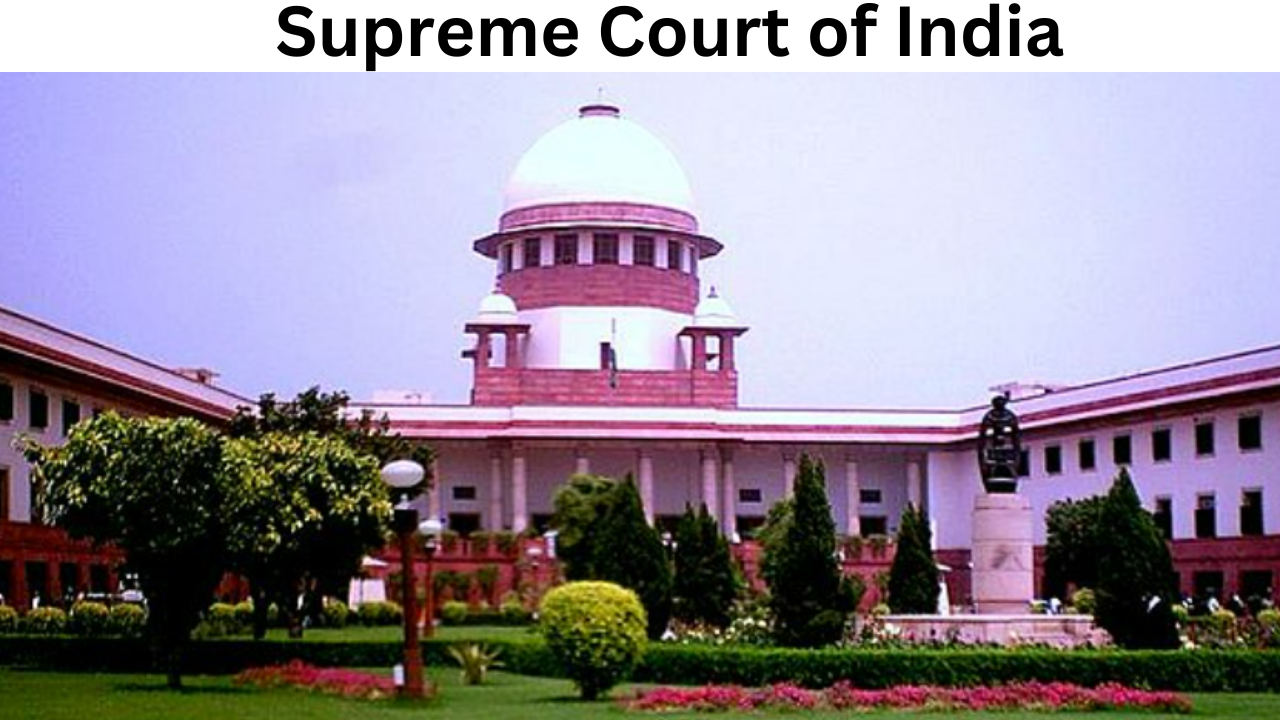The Supreme Court of India topic holds utmost significance for students in their upcoming exams. Understanding the structure, functions, and landmark cases of the Supreme Court equips students with essential knowledge about the judiciary system. It enables them to analyze legal principles critically, enhancing their comprehension and performance in exams.

History of Supreme Court of India
The Supreme Court of India is the apex judicial body under the Constitution of India. Article 124 of the Constitution states that “There shall be a Supreme Court of India.”
The Federal Court of India was created as per the GOI Act(Government of India Act) 1935.
This court settled disputes between provinces and federal states and heard appeals against judgements of the high courts.
After independence, the Federal Court and the Judicial Committee of the Privy Council were replaced by the Supreme Court of India, which came into being in January 1950. The Supreme Court came into existence on 26 January 1950 with the coming into force of the Constitution. On 28 January 1950, two days after India became a Sovereign Democratic Republic, the Supreme Court was inaugurated. The inauguration took place in the Chamber of Princes in the old Parliament building where the Federal Court of India sat for 12 years from 1937 to 1950.
The Supreme Court initially functioned from the old Parliament House till it moved to the present building located on Tilak Marg, New Delhi in 1958.
After its inauguration on 28 January 1950, the Supreme Court commenced its sittings in a part of the old Parliament House. The Court moved into a new building in 1958. The first President of India Dr. Rajendra Prasad inaugurated the present building of the Supreme Court of India on 4 August 1958. The building is shaped to project the image of scales of justice. It has a 27.6 meter high dome and a spacious colonnaded verandas. There is a life size figure of Mahatma Gandhi, the apostle of truth and non-violence in the courtyard opposite the Chief Justice’s Court. The statue was unveiled by the 26th Chief Justice of India, Justice A.M. Ahmadi on 1 August 1996. There is also a 7-foot tall statue of Dr. B.R. Ambedkar which was unveiled by Hon’ble President of India, Smt. Draupadi Murmu in the presence of the 50th Chief Justice of India, Dr. Justice D.Y. Chandrachud on 26 November 2023. The statue honours the architect of the Constitution and captures him in a lawyer’s gown, holding a copy of the Constitution in his hand.
Three extensions were made to the original building- for the first time in 1979, then in 1994, and again in 2015.
In 1979, two New Wings – the East Wing and the West Wing were added to the complex.
There are 19 courtrooms in the various wings of the building.
In 1994, the second extension of the building was made which connected the East and the West Wings.
The third extension – the New Extension Block near the Supreme Court Museum was inaugurated by the then Chief Justice of India, Justice H.L. Dattu on 4 November 2015 and some of the Sections from the existing building were shifted to the new building.
On 17 July 2019, Hon’ble President of India, Shri Ram Nath Kovind inaugurated the Additional Building Complex of the Supreme Court of India. The additional complex, with a total built up area of 1,80,700 sq. mts. has five functional blocks and one service block.
The original Constitution of 1950 envisaged a Supreme Court with a Chief Justice and 7 puisne Judges – leaving it to Parliament to increase this number. In the early years, all the Judges of the Supreme Court sat together to hear the cases presented before them. Considering the increase in workload, Parliament increased the number of Judges from 8 in 1950 to 11 in 1956, 14 in 1960, 18 in 1978, 26 in 1986, 31 in 2009 and 34 in 2019 (current strength).
Today, the Judges sit in Benches of two and three and come together in larger Benches of 5 and more to decide any conflicting decisions between benches of the Supreme Court or any substantial questions concerning the interpretation of the Constitution.
The proceedings of the Supreme Court are conducted in English. The practice and procedure of working of the Registry on the judicial side is regulated by the Supreme Court Rules, 2013 and Handbook on Practice and Procedure and Office Procedure. The Supreme Court Officers and Servants (Conditions of Service and Conduct) Rules, 1961 contains the rules with respect to the conditions of service and conduct of the staff attached to the Supreme Court of India.
The Supreme Court of India is the country’s highest judicial court. It is the final court of appeal in the country.
Latest Updates related to the Indian Supreme Court:
On November 9, 2022, Justice D.Y. Chandrachud will take oath as the 50th Chief Justice of India.
15th February 2021: Former Supreme Court Judge, Justice PB Sawant Passed Away on this day.
The Supreme Court is examining a petition relating to the Social Media Firm Facebook and its Messaging Application WhatsApp over their terms of service and privacy policy that were to be out on February 8th, 2021.
13th February 2021: Statement from Supreme Court while dismissing a review petition on the anti-citizenship law protests held in Delhi’s Shaheen Bagh in 2019 – “Right to Protest Cannot Be Anytime, everywhere.”
The Constitution of 1950 envisaged a Supreme Court with one Chief Justice and 7 puisne Judges.
The number of SC judges was increased by the Parliament and currently, there are 34 judges including the Chief Justice of India (CJI).
Functions of Supreme Court Of India
It takes up appeals against the verdicts of the High Courts, other courts and tribunals.
It settles disputes between various government authorities, between state governments, and between the centre and any state government.
It also hears matters which the President refers to it, in its advisory role.
The SC can also take up cases suo moto (on its own).
The law that SC declares is binding on all the courts in India and on the Union as well as the state governments.
Supreme Court Jurisdiction
Jurisdiction Meaning
Jurisdiction is the authority given to a legal body like a court to administer justice within a defined field of responsibility.
The Supreme Court in India has three types of jurisdictions – original, appellate and advisory as provided in Articles 131, 133 – 136 and 143 respectively of the Indian Constitution.
Original Jurisdiction of the SC in India
Original jurisdiction of a court refers to a matter for which the particular court is approached first. In the case of the Supreme Court in India, its original jurisdiction is covered under Article 131. It involves the following cases:
- The SC can issue writs, directions, or orders including writs in the nature of mandamus, habeas corpus, quo warranto, prohibition and certiorari.
- The SC also has the power to direct the transfer of a criminal or civil case from the High Court in one State to the High Court in another State.
- The Arbitration and Conciliation Act, 1996 gives SC the authority to initiate international commercial arbitration.
- It can also transfer cases from one subordinate court to another State High Court
- If the SC deems that cases involving the same questions of law are pending before it and one or more High Courts, and that these are significant questions of law, it can withdraw the cases before the High Court or Courts and dispose of all these cases itself.
- Article 32 of the Constitution provides original jurisdiction to the SC for matters regarding the enforcement of Fundamental Rights.
- Any dispute between two or more States.
- Any dispute between the Indian Government and one or more States.
- Any dispute between the Indian Government and one or more States on one side and one or more States on the other side.
Appellate Jurisdiction
Under this, the Supreme Court can hear cases only when they are appealed against a High Court order.
Advisory Jurisdiction
Under this, the President can request the Supreme Court to offer its opinion on any issue of law or fact.
Review Jurisdiction
This is covered under Article 137 and it gives SC the authority to review its judgements. There are two grounds on which a review is permitted. They are as follows:
- If there has been an apparent error on the face of record leading to the perversity of judgement, or
- If new evidence has been uncovered which was not available earlier despite the best attempt by the party or out of no fault of the party.
Supreme Court Composition
Including the CJI, there are 34 judges in the Supreme Court.
The judges sit in benches of 2 or 3 (called a Division Bench) or in benches of 5 or more (called a Constitutional Bench) when there are matters of fundamental questions of the law is to be decided.
The Procedure of the Supreme Court of India
The Supreme Court of India has powers to consult the president to regulate the practice and procedure of the Court.
The Constitutional Cases are usually decided by a bench consisting of five judges whereas other cases are decided by a bench of at least three judges.
The seat of Supreme Court
As per the Constitution of India, Delhi is declared as the seat of the Supreme Court of India. However, the Chief Justice of India has the power to assign another place (s) as the seat of the Supreme Court. This is only an optional provision and not mandatory.
SC Judge Eligibility
As per Article 124, an Indian citizen who is below 65 years of age is eligible to be recommended for appointment as a judge of the SC if:
he/she has been a judge of one or more High Courts, for at least 5 years, or
he/she has been an advocate in one or more High Courts for at least 10 years, or
he/she is in the opinion of the President, a distinguished jurist.
Independence of Judiciary
The Constitution has many provisions to ensure the judiciary’s independence. They are discussed below:
Security of tenure: The judges of the SC are given security of tenure. Once appointed, they will retain their office until the age of 65 years. They can be removed only by a presidential order on grounds of proven misbehaviour and/or incapacity. This requires a Special Majority according to Article
Salaries and allowances: The judges of the SC enjoy good salaries and allowances and these cannot be decreased except in the case of a financial emergency. The expenses of the High Court are charged on the Consolidated Fund of the State, which is not subject to vote in the state legislature.
Powers and Jurisdiction: The SC’s powers and jurisdiction can only be added by the Parliament and not be curtailed.
The conduct of any judge of the Supreme Court in the discharge of his/her duties cannot be discussed in the legislature.
The SC has the power to punish any person for its contempt, as per Article 129.
Separation of the Judiciary from the Executive: A DPSP(Directive Principle of State Policy) says that the state shall take steps to separate the judiciary from the executive in the public services of the state. According to Article 50, there shall be a separate judicial service free from executive control.
